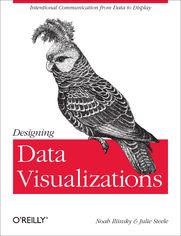Designing Data Visualizations. Representing Informational Relationships - Helion

ISBN: 978-14-493-1706-5
stron: 114, Format: ebook
Data wydania: 2011-09-16
Ksi─Ögarnia: Helion
Cena ksi─ů┼╝ki: 42,42 z┼é (poprzednio: 49,33 z┼é)
Oszczędzasz: 14% (-6,91 zł)
Data visualization is an efficient and effective medium for communicating large amounts of information, but the design process can often seem like an unexplainable creative endeavor. This concise book aims to demystify the design process by showing you how to use a linear decision-making process to encode your information visually.
Delve into different kinds of visualization, including infographics and visual art, and explore the influences at work in each one. Then learn how to apply these concepts to your design process.
- Learn data visualization classifications, including explanatory, exploratory, and hybrid
- Discover how three fundamental influences—the designer, the reader, and the data—shape what you create
- Learn how to describe the specific goal of your visualization and identify the supporting data
- Decide the spatial position of your visual entities with axes
- Encode the various dimensions of your data with appropriate visual properties, such as shape and color
- See visualization best practices and suggestions for encoding various specific data types
Osoby które kupowały "Designing Data Visualizations. Representing Informational Relationships", wybierały także:
- Jak zhakowa 125,00 zł, (10,00 zł -92%)
- Biologika Sukcesji Pokoleniowej. Sezon 3. Konflikty na terytorium 126,36 zł, (13,90 zł -89%)
- Windows Media Center. Domowe centrum rozrywki 66,67 zł, (8,00 zł -88%)
- Podręcznik startupu. Budowa wielkiej firmy krok po kroku 92,67 zł, (13,90 zł -85%)
- Ruby on Rails. ─ćwiczenia 18,75 z┼é, (3,00 z┼é -84%)
Spis tre┼Ťci
Designing Data Visualizations. Representing Informational Relationships eBook -- spis tre┼Ťci
- Designing Data Visualizations
- A Note Regarding Supplemental Files
- Preface
- How This Book Is Organized
- What We Mean When We Say
- Figures Used by Permission
- See the Color Figures Online
- Attributions and Permissions
- Safari Books Online
- How to Contact Us
- Acknowledgments
- I. What Will You Design?
- 1. Classifications of Visualizations
- Complexity
- Infographics versus Data Visualization
- Infographics
- Data Visualization
- Exploration versus Explanation
- Exploration
- Explanation
- Hybrids: Exploratory Explanation
- Informative versus Persuasive versus Visual Art
- The Designer-Reader-Data Trinity
- Informative
- Persuasive
- Visual Art
- 2. Source Trinity: Ingredients of Successful Visualizations
- Designer
- Why Are You Here?
- Reader
- You Are Creating This for Other People
- They Are Not You
- Contextual Considerations for the Reader
- Context of Use
- Data
- Designer
- 1. Classifications of Visualizations
- II. How Should You Design It?
- 3. Determine Your Goals and Supporting Data
- Knowledge Before Structure
- Avoiding TMI
- 4. Choose Appropriate Visual Encodings
- Choosing Appropriate Visual Encodings
- Natural Ordering
- Color is not ordered
- Distinct Values
- Redundant Encoding
- Defaults versus Innovative Formats
- Readers Context
- Titles, tags, and labels
- Colors
- Color blindness
- Directional orientation
- Compatibility with Reality
- Direction and reality
- Patterns and Consistency
- Natural Ordering
- Selecting Structure
- Comparisons Need to Compare
- Some Structures Are Just Inherently Bad
- Some Good Structures Are Often Abused
- Keep It Simple (or You Might Look) Stupid
- Choosing Appropriate Visual Encodings
- 5. First, Place
- Position: Layout and Axes
- Position Is Your Most Powerful Encoding
- Consider placement first
- Position Is Your Most Powerful Encoding
- The Meaning of Placement and Proximity
- Semantic Distance and Relative Proximity
- Absolute Placement
- Representation of Physical Space
- Logical Relationships versus Physical Relationships
- Patterns and Grouped Objects
- Patterns of Organization (and More!)
- Specific Graphs, Layouts, and Axis Styles
- Quantitative and comparative formats
- Relational formats
- Spatial formats
- Appropriate Use of Circles and Circular Layouts
- Good uses of circles and circular layouts
- Bad uses of circles and circular layouts
- Specific Graphs, Layouts, and Axis Styles
- Position: Layout and Axes
- 6. Apply Your Encodings Well
- Color
- Leverage Common Color Associations
- Cognitive Interference and the Stroop Test
- Color Theory
- Spatial perception of color
- RGB versus CMYK
- Size
- Conveying Size
- Comparing Sizes
- Text and Typography
- Use Text Sparingly
- Fonts and Hierarchies
- Beware of All Caps
- Avoid Drop Shadows
- Shape
- Cultural Connotations
- Icons
- Illusions
- Lines
- When Not to Use Lines
- Keys versus Direct Labeling of Data Points
- Pitfalls to Avoid
- 3D
- Pies
- Gradients
- Drop Shadows
- Any Excel Defaults
- Conclusion
- Color
- A. Additional Resources
- Tools
- Reading List
- B. Checklist
- Determine Your Goals and Supporting Data
- Consider Your Reader
- Select Axes, Layout, and Placement
- Evaluate Your Encoding Entities
- Reveal the Datas Relationships
- Choose Titles, Tags, and Labels
- Analyze Patterns and Consistency
- 3. Determine Your Goals and Supporting Data
- About the Authors
- Copyright





